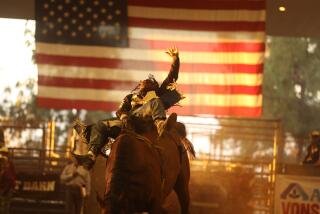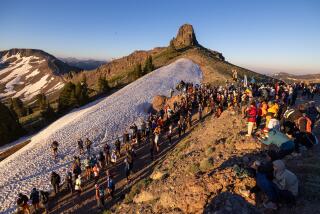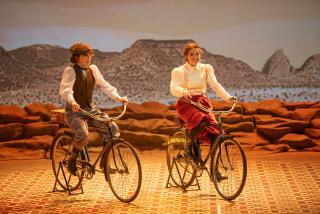When three’s not a crowd
- Share via
Fort Bragg, Calif. — Celina BRUN hides her hands inside her sweatshirt sleeves at the edge of the campfire. She’s 17, wears $10 running shoes and has never been to a Ride & Tie. She skirts the crowd, apprehensive about the hours and miles she will spend in oddly disjointed teamwork with a gray-haired man and a horse she has never met.
Kathy Broaddus already knows her human partner, Lani Newcomb, but now the two are nervous about meeting their other, arguably more important teammate -- the horse.
Combine two people, one horse, 34 miles of trail and you’ve got yourself a race. A Ride & Tie. Through open fields and hilly forests, one person rides the horse while the other takes off on foot. They switch places along the way: The rider ties up the horse, and the runner catches up, unties, and hops into the saddle. They repeat this leapfrog routine until the finish
Some horse and rider trinities have worked together for years. Some competitors come to a race seeking a partner or partners -- a human, a horse or both. But it’s the dynamic between human and horse that’s most important. A horse can do interesting things to long-standing relationships, let alone a twosome thrown together solely by a mutual affection for this peculiar event.
Brun is still fretting when Dave VanWicklin pulls onto the camping field from Foresthill, Calif., towing a double horse trailer behind an aquamarine pickup also hauling his wife and daughter. He takes off his cowboy hat to sleep, shower and run. He can jog 100 miles, and his horse, Jazz, was born to Ride & Tie. As for Brun, his new partner, VanWicklin, smiles in a way that says, “We’ll see.”
Defining fun
Ask anyone why they have trucked their tack from as far as Australia and Germany to this Ride & Tie World Championship in Fort Bragg, and the answer is always “because it’s fun.”
Parcheesi is fun. This is Ride & Tie.
Bud Johns invented this sport in 1971 as a promo for Levi Strauss: The first team to cross the finish line won $1,000 and another grand if they wore the company’s trademark jeans. Levi Strauss bowed out of the event in the late 1980s, and with it went the prize money. Now, winners get cowboy boots, belt buckles or a couple bottles of wine.
Veterinarians Broaddus and Newcomb of Purcelville, Va., have raced in more than 70 Ride & Ties. Broaddus moseys around in muscle tees. Newcomb, less chiseled, ambles in Hawaiian print button downs.
They had hoped to lease a 20-year-old nag for the championship. Instead, behind an aluminum port-o-corral, they shell out $750 to ride Victory, a surly, teenage Arabian. Broaddus mounts and grips the reins. They know chance is part of the game. “You ride horses,” says Newcomb, “and it’s not a matter of if you get thrown, it’s when.”
Veteran racer VanWicklin knows his horse well. “He’s scared o’ white,” says VanWicklin, gesturing to Jazz, a name short for Jasuur Al Baraq, which means “at one with lightning” in Arabic. “Like that white, plastic bag over there.”
On the championship course, white sandwich boards loom at trail intersections. White paper plates are tacked at trailheads. A white trough stands at the veterinary checkpoint, and the path is marked every few feet with white, plastic ribbons.
When Brun returned from a practice ride, her arms were limp from wrestling the reins. In her dude-ranch days, she’d never met one as strong and high-strung as Jazz. She was dirty and shaken but was, says VanWicklin, “a finish-line gal.”
At 9 a.m. Saturday, Johns starts the race by lifting what looks like an Amish hat off his head and pulling it to his knees. Thirty-two horses file to the road, and a herd of runners follows.
Brun, wearing a pair of borrowed tights, starts Loop 1, which begins uphill on a trail barely wide enough for a horse to put one hoof in front of the other. The route levels off in tall grass, where runners huff behind their steeds, breathing dust and brine and fresh-cut hay.
At the summit, anyone with time to look can watch the Pacific add to the sands of Ten Mile Beach. But even a glance away from the pitted path could cost ankle injuries, or worse. The loop, which spins through redwoods and Douglas fir, is a little more than 16 miles; the second and third are nine miles each.
Broaddus pounds out the first mile. In her head, some song is stuck on repeat. Later she won’t even remember what it was, just that it drowned out the static of other runners’ thuds.
Around a tree, a rope hangs chest-high where Newcomb knotted it. Victory is waiting. “He’s not a touchy-feely horse,” Newcomb had said earlier. “He doesn’t like to be all ‘oogie, oogie, oogie.’ ”
Broaddus inches toward the horse clutching a handful of grass and extends the offering. Victory accepts. Broaddus sticks her left foot into the stirrup and swings her right leg over the horse. A rush of relief. “Oh, you’re golden,” she says.
In this race, humans can finish lame, but the horse must be sound. Veterinarian Jim Steer, head vet since ‘72, waits with crew members until the leader charges down for a first loop inspection. It’s also where friends and family station lawn chairs against a glaring sky and a constant wind.
At 10:45 a.m., the first team shuffles in. Sometime after noon, Brun stumbles past the corral gate and into one of the chairs.
VanWicklin already has dismounted from Jazz and continues on foot for the second loop. Now, Brun must hop in the saddle and catch up on the trail.
VanWicklin’s wife, Beth, injects bran mash onto Jazz’s tongue and clears his pulse and respiration rate through vet check -- each must be lower than 72 beats per minute. She holds the reins while Brun mounts. “I realize now,” Brun says in an exhausted monotone, “how hard it is. I just want to finish alive.”
Meanwhile, Victory trots into the checkpoint corral. In 1997, Broaddus rounded a corner at a Ride & Tie in Mendocino, just south of Fort Bragg, and scanned the trail for their leased horse. She froze. “Lani’s splat on the ground lying in a heap. She was out cold,” Broaddus said.
Minutes later, Newcomb opened her eyes, said her left arm hurt and, just eight miles from the starting line, insisted they finish. “My first conscious thought was, ‘I paid so much money to get here,’ ” she says.
Newcomb’s helmet was dented and her collarbone broken in three places. With a roll of elastic bandage, Broaddus sheathed her partner from shoulder to chest and fed her a painkiller.
In an hour and a half, the horse -- bathed in dirt from cartwheeling over a water bar -- was rescued by another entrant. Newcomb mounted him. Broaddus ran. Out of 80 teams, the pair placed 62nd.
Surviving that puts Victory’s mood swings into perspective.
Do not faint
While Broaddus hums a nameless tune, Brun slows to read a prayer. “They shall run and not be weary. They shall walk and not faint.” Beth VanWicklin slipped the scripture into her hand that morning. Brun stuck it in her pocket as she stood outside the RV she rode in from Arizona. Now, as Brun sways in calorie deficiency, she talks herself through another steep mile. She must keep up with her partner.
At the final half-mile marker, quiet alternates with chaos. Hoofs pound through silent fern groves onto a footbridge. Some horses halt short to sip water or nibble a tender blade of grass before heaving up the final two hills. Six hours into the race, most of the runners are walking. Brun, accustomed to training across flat, desert sands, rounds the bend smiling and running hard.
Jazz is on her heels. He steps into the creek and sinks up to his haunches in mud. In a second he’s out again, VanWicklin, high in the saddle, whoops, “C’mon, Jazz, you got more gas. Woo!”
Newcomb follows on Victory. With a quarter mile to go, she ties the horse to a young fir and steals away to the finish on the verge of giggles. Broaddus powers in from behind, leaps onto Victory and charges the incline.
At 6 hours and 4 minutes, Brun takes Jazz home. At 6 hours and 38 minutes, Broaddus finishes with Victory. Each passes the final vet check.
An hour later, Ride & Tie officially ends when George Hall, sporting two new artificial hips and the same Levi cutoffs he wore in ‘71, crosses with his partners in 31st place.
The champs finished in just 4 hours. One team did not finish. Still, at Ride & Tie, no one’s really counting.
In a white tent crammed with picnic tables, Newcomb accepts the belt buckles and bumper stickers that reward 25th place. Then she halts and strides back to the announcer when she hears her four-legged partner announced as Lakota Mare. “Victory needs credit for this, OK?”
Outside Brun leads Jazz across the knee-high grain to the trailer. She pats him down, and tugs at his blanket. This likely won’t be the last time Brun will see the VanWicklins or the ranch at Ten Mile Beach. In future races, her partners may change, but Brun vows in her journal that she’ll return next year.
It’s a promise to be there. This is Ride & Tie.
Times staff writer Ashley Powers contributed to this report.
More to Read
Sign up for The Wild
We’ll help you find the best places to hike, bike and run, as well as the perfect silent spots for meditation and yoga.
You may occasionally receive promotional content from the Los Angeles Times.






